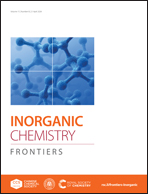Structural phase transition drives outright photoluminescence quenching and dielectric duple bistable switching†
Abstract
Organic–inorganic metal halides (OIMHs) possessing switchable optical and electrical properties hold significant promise for applications in multifunctional sensors, switching devices, and information storage. However, the challenge lies in achieving effective regulation of optical/electric responses through structural design strategies, and materials with structural phase transition coupling photoluminescence (PL) quenching are also relatively rare. Here, by employing halogen engineering to modify the parent compound (TEMA)PbBr3 (TEMA = triethylmethylammonium), we successfully obtained two derivatives (TECA)PbBr3 and (TEBA)PbBr3 (TECA = triethylchloromethylammonium and TEBA = triethylbromomethylammonium). Halogen engineering successfully introduces halogen–halogen interactions between PbBr3n− inorganic frameworks and organic cations, which increases the stretching distortion of the PbBr6 octahedral framework of (TECA)PbBr3 and (TEBA)PbBr3, accompanied by prominent orange-red broadband emission behavior in (TECA)PbBr3 and (TEBA)PbBr3. Meanwhile, the phase transition temperatures (Tp) of (TECA)PbBr3 and (TEBA)PbBr3 have also been significantly increased compared to (TEMA)PbBr3, and two derivatives demonstrated switchable dielectric responses. Impressively, the reversible structural phase transition of (TECA)PbBr3 and (TEBA)PbBr3 dominates the outright PL quenching behavior, while still maintaining high PL emission intensity below the Tp. This represents a rare and extraordinary phenomenon in the realm of bistable responsive materials. This work provides a feasible strategy for designing and modulating photoluminescent phase transition materials and deepens understanding of the structural–performance relationship.

- This article is part of the themed collection: 2024 Inorganic Chemistry Frontiers HOT articles


 Please wait while we load your content...
Please wait while we load your content...